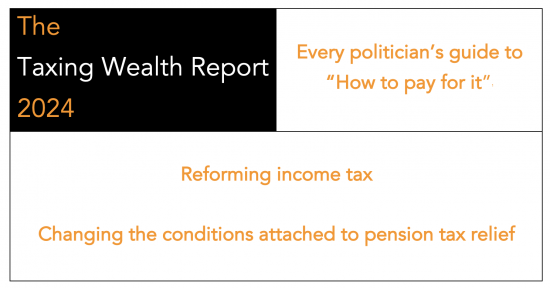I have this morning published the latest note in my series that will make up the Taxing Wealth Report 2024.
This latest note refers to a proposed change in the conditions to be attached to pension tax relief. Doing so it updates previous proposals I have made on this issue and complements the proposals made recently on ISA reform.
Pension saving published 
The summary of this note says:
Brief Summary
This note proposes that in exchange for the tax relief given on qualifying pension contributions made to a UK pension fund that one-quarter of the contributions made should be invested in investments that would fund:
- The required climate transition if net-zero goals are to be achieved.
- New social housing.
- Other new social infrastructure.
- Related training, education and support services.
A further object of this exercise is to provide the opportunity for UK pension funds, which now have a marked preference for bond investment, to do so in a way that permits active choice by the funds and their members in the activities in which they would wish such savings to be used when at present very few bond saving opportunities make any link between funds saved and activity in the real economy.
Given that more than 77 per cent of the UK's financial wealth is saved in pension funds and at least 85 per cent is saved in tax-incentivised assets it is thought unlikely that there will be any significant adverse behavioural response to this proposal.
The proposal does not apply to any past sums invested.
It is thought that this proposal would release at least £35 billion per annum for investment in the activities noted, saving the government from having to do so as a result and providing it with a positive return on its own contribution to pension savings as a consequence. Without any other measure of the impact of this proposal being available, this sum is used for that purpose since it releases an equivalent amount for spending on alternative UK government budgets as a result.
Discussion
In a previous note in this series[1], it was suggested that the cost of pension tax relief to the UK Exchequer is about £65 billion per annum. Suggestions were made as result to restrict that relief in the case of higher rate taxpayers and to save more than £14 billion of that cost a year as a consequence.
In another note in the series[2], it was noted that the cost of tax relief given to those who save in ISA accounts did not give rise to a commensurate economic benefit to the government in exchange for the tax relief given. As a consequence, it was suggested that the tax relief given on ISA accounts should be made conditional upon the funds saved in such accounts being used for appropriate social purposes.
In this note, those two observations are combined to make suggestion that in addition to pension tax relief being restricted to the basic rate of tax, irrespective of the income tax rate paid by the person making the contribution, the receipt of pension tax relief on contributions made by a person to a pension fund should be conditional upon at least part of the contribution that they make being made available to fund investment for social and economic programmes consistent with the objectives of the government granting such relief. In this way, the exceptional cost of pension tax relief (which is at present almost exactly equivalent to the current spending on schools in England[3]) could, at least, give rise to a commensurate return for the sum expended.
There is another reason for suggesting this reform. It is already Labour and Conservative Party policy to encourage greater direct investment by UK pension funds in the UK economy, both having noted how little direct engagement between pension funds and the underlying economy that there is. This is not least because of the marked preference of most pension funds for bond-based investment, little of which can be directly related to investment activity in the real economy, which is an issue that needs to be addressed.
This proposal could be achieved if pension funds invested in:
- UK government green saving bonds of the type now issued through NS&I, which is the government's own savings bank. The use of these funds is noted by the government in occasional reports
- Green gilts issued by the UK government which are now becoming more commonplace.
- Bonds issued by a UK government-owned national investment bank that had as its purpose investment in the above-noted categories of assets, on which returns could be paid by their users.
- Private sector funds meeting the above-noted required specification for investment could be used for this purpose. A very clear taxonomy requiring strong evidence of the actual investment of funds raised for green purposes would be required for any company to qualify to raise funds in this way.
It is stressed that the majority of UK financial savings are held in pension arrangements. It is likely that in 2020, when the most recent data with regard to this issue was published, that seventy-seven per cent of all UK financial assets were represented by pension savings. If ISAs are taken into account, it is likely that at the same date approximately eighty-five per cent of all financial assets were held in some form of tax-incentivised savings arrangement. It is therefore very unlikely that there would be a significant behavioural reaction to this proposal with people withdrawing their savings from pension arrangements as a result of it.
Cumulative value of recommendations made
The recommendations now made as part of the Taxing Wealth Report 2024 would, taking this latest proposal into account, raise total additional tax revenues or (in the case of this proposal) release sums available for alternative spending of approximately £150.1 billion per annum.
Footnotes
[1] https://www.taxresearch.org.uk/Blog/wp-content/uploads/2023/09/Restricting-pension-tax-relief-published-1.pdf
[2] https://www.taxresearch.org.uk/Blog/wp-content/uploads/2023/11/The-use-of-ISAs-published.pdf
[3] Based on data here: https://www.gov.uk/government/publications/autumn-statement-2023/autumn-statement-2023-html
Thanks for reading this post.
You can share this post on social media of your choice by clicking these icons:
You can subscribe to this blog's daily email here.
And if you would like to support this blog you can, here:



When you say ‘should be invested’, do you mean ‘must be spent’.
The reason I ask is that it does sound like it would be compulsory to get the tax relief, and secondly pensions are already invested in green and social projects that give a return so I’m presuming that your proposal is in those other green and social projects that would not give a return, hence the compulsion.
Don’t get me wrong, this may not be a bad idea, just trying to clarify what is being meant by ‘should be invested’
Yes, of course it is compulsory.
But past spends can’t count towards the total. This must be new money.
But what you deliberately mis-state, because you are a troll, is that new projects would not make a return. Of course they could and would. They have just been crowded out by market speculation to date, which failing this measure addresses.
Polly Toynbee cites Margaret Hodge’s suggestion as to how Labour could find more money. It seems mainly through more crack down on tax dodging by wealthy people and large companies, and also looking at the many tax-reliefs.
She seems to think Reeves might use some of Hodge’s suggestions – as she hasnt ruled them out explictly .
Obviously the Hodge/Toynbee perspective is within the official Labour ‘fiscal rules’ – but maybe there is a glimmer of hope that they realise they have to look for new ideas/ways of doing things.
We can hope
But without big spending at HMRC nothign will happen
Richard,
I have previously made various suggestions about pension options.
I would suggest that the State Pension should include an ‘AVC’ option. If you look at most Public Sector pensions you have the option to purchase up to £7000pa in additional pension. I might suggest that anyone should be able to purchase some extra pension through the state scheme.
I would suggest tat the state scheme should offer up to 50% of what the public sector pensioners can buy, ied £3500pa at current prices and that you should not be able to invest in a Private Pension until you have used up that allowance.
This would then be ;invested’ in the sort of [rojects you are talking about and as its a state run scheme the admin costs are minimal
I like that